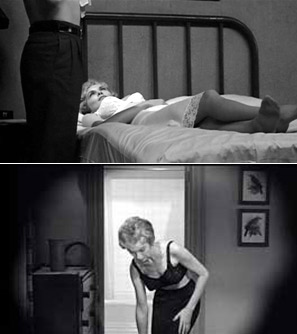The Actress. A Book.
 Thursday, August 25, 2011 at 8:42PM
Thursday, August 25, 2011 at 8:42PM It took a surprisingly long time but three of my friends independently read the book What You See in the Dark these past two weeks. I had recommended it emphatically a few months back but dropped the topic when nobody bit. All three of them told me much they liked it in separate conversations. Some of you may recall that I interviewed the author Manuel Muñoz right here, hoping some of you would pick it up as well.
Since it was on my mind again, I thought I'd share a passage so I flipped the book open and skimmed until I found one of the passages about the Actress (who it won't surprise you to hear was my favorite character in the novel... although not by much, which surprised me).
The scene takes place as the Actress is contemplating a scene she'll be shooting the next morning and her mind wanders...
A supporting role. Nothing more. In the Director's previous picture, that one actress had appeared playing two roles. She hadn't done a particularly stellar job, some in the industry had said, but the Actress thought the performance more than adequate. She had sat in the theater with mild envy, the role too rich for words: A distraught wife is trailed silently throughout San Francisco by a police detective, from flower shop to museum to the foot of the glorious Golden Gate Bridge, where she finally hurls herself into the bay. The detective rescues her and later falls in love, only to lose her again to a successful suicide attempt. It played, the Actress thought, like an odd type of silent movie, and she felt maybe she had fooled herself into believing she could have fit perfectly into the part. Was it really requiring much beyond posing, or was there something about silent-movie acting that she didn't know? She wondered what the script must have looked like, that other actress -- who couldn't have been professionally trained -- skimming the pages until she found her first line.
No matter how small the role was going to be, it would have been foolish to say no to the Director. He was in the midst of doing something extraordinary and uncanny with some actresses, finessing their star wattage and burnishing it into a singular, almost iconic image. That was the way the Actress saw it anyway, mesmerized by how he was stripping out all the trappings of the industry and pushing these women toward something beyond even acting, something nakedly cinematic -- poses, postures, gestures, as if the women were in magazine ads come to life for just split seconds at a time, just enough motion for the public to remember them as images and not characters. It was like opening up a jewelry box she had had many years ago as a young girl, fascinated by the tiny plastic ballerina in the center and its brief circle of motion. She had closed and opened that box endlessly even though the ballerina did nothing differently. But even now, in a black sedan carrying her over the Grapevine back toward the Valley, where she had grown up, the Actress could close her eyes and remember the golden lace of the ballerina's costume, the full circle of her deliciously patient twirl, her perfect timing with the delicate chime of the music box's single tune. And that was the way the screen worked, too, she had discovered. Every actresses's trajectory carried a moment like that, and the Director was staging them effortlessly.
After the jump a brief bit about the Actress's brassiere.
Ma'am, I know where I can have you fitted for some black brassieres, a wardrobe mistress assured her. Very elegant, very discreet.
The script made no claim on morals, on shame, on right and wrong. But there were white brassieres and black ones, a black purse matched by a white one. What for, if only to signal the audience? Were things ever so clear in real life?
 Actressexuality,
Actressexuality,  What You See in the Dark,
What You See in the Dark,  books
books 



Reader Comments (4)
I really can't wait to start reading this book once I get the chance: I'm trying to get through three other books at the moment (right now: Never Let Me Go, and afterward: Freedom, and Swamplandia), but once I finish them, Manuel's book really just sounds fantastic. Can't wait!
It's quality writing like this which shames me as an amatuer author.
I just read it myself (at a great price in the Kindle store, btw) and I rather enjoyed it as well!
Could you see this book as afilm Nate? I've put it on my to read list.